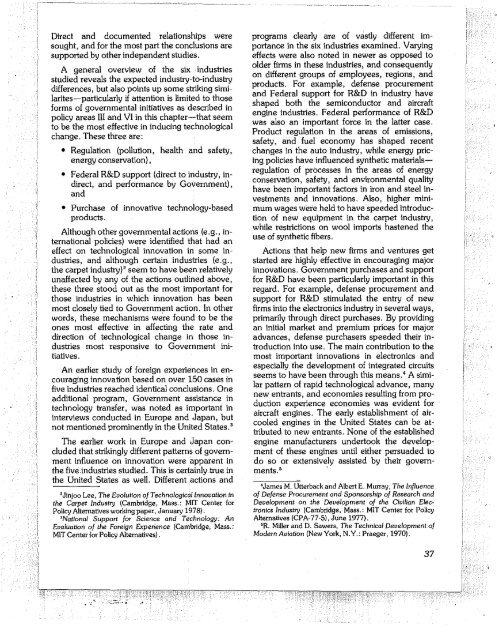Office of Technology Assessment - Bayhdolecentral
Office of Technology Assessment - Bayhdolecentral
Office of Technology Assessment - Bayhdolecentral
Create successful ePaper yourself
Turn your PDF publications into a flip-book with our unique Google optimized e-Paper software.
Direct and documented relationships were<br />
sought, and for the most part the conclusions are<br />
supported by other independent studies.<br />
A general overview <strong>of</strong> the six industries<br />
studied reveals the expected industry-to-industry<br />
differences, but also points up some striking similarites-particularly<br />
if attention is limited to those<br />
forms <strong>of</strong> governmental initiatives as described in<br />
policy areas III and VI in this chapter-that seem<br />
to be the most effective in inducing technological<br />
change. These three are:<br />
• Regulation (pollution, health and safety,<br />
energy conservation),<br />
• Federal R&D support (direct to industry, indirect,<br />
and performance by Government),<br />
and<br />
• Purchase <strong>of</strong> innovative technology-based<br />
products.<br />
Although other governmental actions (e.g., international<br />
policies) were identified that had an<br />
effect on technological innovation in some industries,<br />
and although certain industries (e.g.,<br />
the carpet industry)' seem to have been relatively<br />
unaffected by any <strong>of</strong> the actions outlined above,<br />
these three stood out as the most important for<br />
those industries in which innovation has been<br />
most closely tied to Government action. In other<br />
words, these mechanisms were found to be the<br />
ones most effective in affecting the rate and<br />
direction <strong>of</strong> technological change in those industries<br />
most responsive to Government initiatives.<br />
An earlier study <strong>of</strong> foreign experiences in encouraging<br />
innovation based on over 150 cases in<br />
five industries reached identical conclusions. One<br />
additional program, Government assistance in<br />
technology transfer, was noted as important in<br />
interviews conducted in Europe and Japan, but<br />
not mentioned prominently in the United States. 3<br />
The earlier work in Europe and Japan cow<br />
eluded that strikingly different patterns <strong>of</strong> government<br />
influence on innovation were apparent in<br />
the fiveindustries studied. This is certainly true in<br />
the United States as well. Different actions and<br />
2Jinjoo Lee, The Evolution <strong>of</strong> Technological Innovation in<br />
the Carpet Industry (Cambridge, Mass.: MIT Center for<br />
Policy Alternatives working paper, January 1978).<br />
3National Support for Science and <strong>Technology</strong>; An<br />
Evaluation <strong>of</strong> the Foreign Experience (Cambridge, Mass.:<br />
MIT Center for Policy Alternatives).<br />
programs clearly are <strong>of</strong> vastly different importance<br />
in the six industries examined. Varying<br />
effects were also noted in newer as opposed to<br />
older firms in these industries, and consequently<br />
on different groups <strong>of</strong> employees, regions, and<br />
products. For example, defense procurement<br />
and Federal support for R&D in industry have<br />
shaped both the semiconductor and aircraft<br />
engine industries. Federal performance <strong>of</strong> R&D<br />
was also an important force in the latter case.<br />
Product regulation in the areas <strong>of</strong> emissions,<br />
safety, and fuel economy has shaped recent<br />
changes in the auto industry, while energy pricing<br />
policies have influenced synthetic materialsregulation<br />
<strong>of</strong> processes in the areas <strong>of</strong> energy<br />
conservation, safety, and environmental quality<br />
have been important factors in iron and steel investments<br />
and innovations. Also, higher minimum<br />
wages were held to have speeded introduction<br />
<strong>of</strong> new equipment in the carpet industry,<br />
while restrictions on wool imports hastened the<br />
use <strong>of</strong> synthetic fibers.<br />
Actions that help new firms and ventures get<br />
started are highly effective in encouraging major<br />
innovations. Government purchases and support<br />
for R&D have been particularly important in this<br />
regard. For example, defense procurement and<br />
support for R&D stimulated the entry <strong>of</strong> new<br />
firms into the electronics industry in several ways,<br />
primarily through direct purchases. By providing<br />
an initial market and premium prices for major<br />
advances, defense purchasers speeded their introduction<br />
into use. The main contribution to the<br />
most important innovations in electronics and<br />
especially the development <strong>of</strong> integrated circuits<br />
seems to have been through this means.' A similar<br />
pattern <strong>of</strong> rapid technological advance, many<br />
new entrants, and economies resulting from production<br />
experience economies was evident for<br />
aircraft engines. The early establishment <strong>of</strong> aircooled<br />
engines in the United States can be attributed<br />
to new entrants. None <strong>of</strong> the established<br />
engine manufacturers undertook the development<br />
<strong>of</strong> these engines until either persuaded to<br />
do so or extensively assisted by their governmerits."<br />
.<br />
'James M. Utterback and Aibert E. Murray, The Influence<br />
o!Defense Procurement and Sponsorship <strong>of</strong> Research and<br />
Development on the Development <strong>of</strong> the Civilian Electronics<br />
Industry (Cambridge, Mass.: MIT Center for Policy<br />
Alternatives (CPA-77-5), June 1977).<br />
5R. Miller and D. Sawers, The Technical Development <strong>of</strong><br />
Modem Auiation (NewYork, N.Y.: Praeger, 1970).<br />
37
















